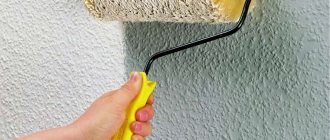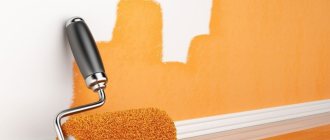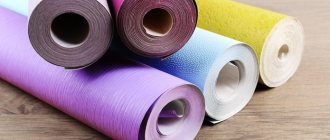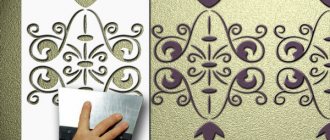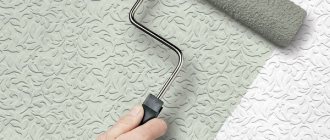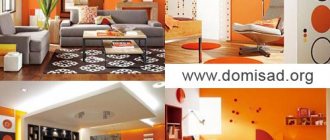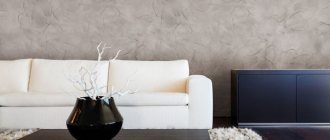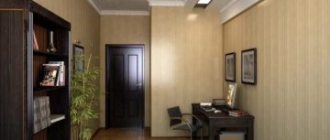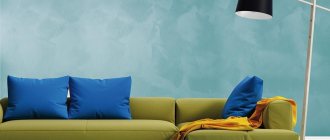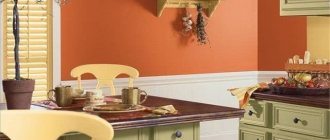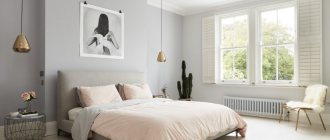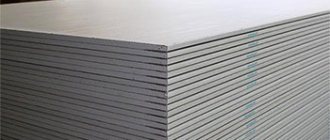Today, textured wall paint is very popular among finishing materials. With its help, you can achieve a relief surface, create a unique texture, and even save on preparatory work. The consistency of the paint is very dense and viscous; when applied, the thickness of the coating is much greater than that of conventional paint. Consequently, the time for preparatory work is reduced, since there is no need to perfectly level the surface of the walls. If desired, this paint can be used for the ceiling.
Main advantages of the material
The texture dye contains a binder acrylic polymer. Thanks to this, the material has the following qualities:
- used for both external and internal work;
- with increased moisture resistance, resistant to temperature fluctuations and precipitation;
- prevents the appearance of mold;
- durable, resistant to chemical influences;
- decorative relief is not modified;
- easy to care for, environmentally friendly;
- used for texturing walls with uneven surfaces;
- By adding color pigment it is possible to achieve any shade.
On video: how to apply the Fur coat effect.
Types of decorative and finishing materials
There are many ways to create relief patterns and ornaments on walls. These include finishing with paintable wallpaper, decorative plaster, gypsum wall panels and many other design methods. The simplest solution to this interior problem is the use of textured paint. The abundance of its modifications is divided into types with different bases:
- Water-dispersed is made from latex components with high hypoallergenic properties. This paint and varnish mixture withstands the effects of chemical detergents, which greatly facilitates the care of textured wall cladding. In order not to damage the glossy finish and the shape of the texture, it is not recommended to use hard brushes, sponges, or cleaning compounds with abrasive components.
Water-dispersible textured paint is hypoallergenic
- Mineral is made from lime and cement. Thanks to the use of natural components with a water base, it is considered the most environmentally friendly finishing material for indoor use.
Mineral textured paint is considered the most environmentally friendly
- Acrylic with a polymer base can be easily combined with all kinds of additives that create relief for the coating. It has excellent vapor permeability, causing intense air circulation. It is advisable to use it for finishing stuffy and damp rooms - kitchens or bathrooms. It does not poison the air with volatile substances harmful to health, and does not create a suffocating odor after painting.
Acrylic paint combines well with all kinds of additives
- Vinyl is considered a universal paint due to its excellent compatibility with surfaces made of concrete, brick, timber or glass. It is necessary for cladding monolithic walls or room partitions.
Vinyl textured paint is considered universal
Types of paint and popular brands
Texture paint for walls is divided into categories that differ from each other in composition; with its help, a relief texture is achieved:
- finishing composition for facade surfaces;
- textured painting material for interior decoration;
- universal paint (for interior and exterior use);
- fine grain dye;
- texture paint with coarse composition.
When choosing a material for decorative painting of walls (or for the ceiling), you should not give preference to cheap compositions. First, consult with professional builders who have been performing finishing work for many years.
- "TEX Universal" - paint intended for interior and exterior decoration. Can be used to cover walls in the bathroom and kitchen, as it has increased moisture resistance. The durable composition of the paint allows it to be applied in one layer to cement or concrete surfaces.
- “Optimist” is an acrylic-based material, also intended for exterior and interior use. Its spectacular texture will help hide minor wall defects.
On video: a tutorial on applying decorative materials Optimist.
Leading manufacturers of decorative textured paints
These products are produced in many ways and are distinguished by their good quality, durability, and environmental friendliness. Russian produces high-quality products, with different relief options, at an affordable price. "VGT" presents paints for both facades and interior decoration. The product performs well in our weather conditions. French paint "Blancolor" is produced in different variations and is durable.
"VGT" presents paints for both facades and interior decoration.
This paint is an excellent design solution to change the interior of a room. There are various options for the resulting relief, which helps to recreate any project. Painting is not difficult, even beginners can do it.
Tools and materials for work
To paint walls with texture paint you will need to purchase the following tools and materials:
- acrylic putty;
- primer;
- medium size spatula;
- cuvette (tray) for paint;
- rags;
- rollers (regular and structural);
- scraper;
- foam sponge;
- texture paint;
- workwear.
If you don't have a structure roller, you can easily make one yourself. For this you will need a rough rag. Attach the rag to the roller with thread and get to work.
Special tool for decorative finishing
To obtain a certain relief and pattern when painting walls in an apartment with textured paint, use special means at hand:
- Curly roller with a convex pattern. To ensure that the pattern is not interrupted, the area from floor to ceiling is processed in one motion.
- A regular roller with a foam or fur coat. In this case, the relief will depend on the type and length of the pile. To get a rough surface, you just need to roll the roller over fresh paint.
- Putty knife. Using this tool, surfaces can be shaped into stone. It is difficult to do this without some skill, since the dye is applied in a thin layer using special sharp and rough movements.
- Comb. Lines are drawn across the still wet composition in any direction using a comb, resulting in a rare and pronounced relief.
- Wide brush or brush. The relief will be less pronounced, but beautiful, if you use a brush or brush instead of a comb. These tools can draw horizontal, vertical, wavy and any other lines.
- Crumpled paper, a rag or a natural sponge are used to stamp freshly painted surfaces. This technology is called “facing”.
Preparing walls for painting
The walls must first be cleaned of dirt. This can be done with water, detergent and a cloth. Use a spatula or scraper to remove any remaining old coating. If there are cracks or gouges on the surface, fill them with acrylic putty. Once completely dry, coat the entire wall with primer. Leave to dry for approximately 12 hours.
Preparation before painting is required. Texture material can hide only minor wall imperfections. And the primer will help the paint adhere more firmly to the surface.
Paint is usually sold in powder or liquid form. First, read the instructions, dilute the powder with water using a construction mixer, and mix the finished paint thoroughly. Now you can add color pigment or mix several paints to achieve the desired shade. The pigment should be added while mixing, so the consistency of the paint will be as uniform as possible.
Do a test job before starting painting. Make a few test strokes with a roller on a small piece of cardboard.
Structural paint tinting
Since this product comes in white, you may need to give it a specific shade. This is usually done at the point of purchase or at color centers, but if necessary, you can do it yourself. To do this, first try painting a test amount of paint and apply it to a non-critical surface. Remember that the paint will darken slightly after drying. Therefore, you need to use the desired proportions only after such a color check.
Having calculated the required proportions, pour the color into the paint, constantly stirring the composition. If there are no strict rules for the shade, then you can simply gradually pour out the color until the desired shade is achieved.
Options for the resulting effects
In the process of applying texture paint, you should consider: whether the pigment is selected correctly, whether it is compatible with the dye, and also choose the desired technique for applying the material. Thanks to these components, you can get a unique relief. Conventionally, finishing can be divided into several types:
- Marseille wax. Externally, the surface resembles a combination of tree bark and natural stone. After the texture paint has completely dried, it is necessary to cover the surface with wax. This will give the walls more depth and a luxurious effect.
- Relief. If you want to create a relief transition of small dots and thin strokes on the wall, sawdust and quartz chips will help you with this. Materials should be added to the paint and mixed thoroughly. It is not difficult to adjust the degree of relief. If a minimum surface grain size is required, sand can be added instead of quartz chips. Here everything will depend on your imagination.
- Atacama. To create a three-dimensional wall surface, it is necessary to add fine metal shavings and sand to the acrylic dye in equal proportions. This composition will create an optical illusion. From different corners of the room it will seem to you that the wall has a reflective velvety base filled with volume.
- Mizuri. The most popular type of surface coating. It's quite easy to achieve this effect. Water and modified starch are added to the paint. After drying, the wall becomes glossy. Sometimes a pigment filler is added to the composition, which allows you to achieve a pearly shine. The paint is applied to the wall in chaotic patterns, resulting in the effect of a wet lye.
Before painting, be sure to wear protective clothing and safety glasses. This will protect your eyes and body from paint.
Application options in photo design
In the gallery you can see many ideas for using textured decorative material.
Applying textured paint to walls is a fun activity that allows beginners to create unique finishes. What this material has in common with decorative plaster is the ability to create texture using various application methods. Also attractive is the opportunity to speed up the process of painting walls (without additional putty).
Texture paint application technique
The consumption of materials depends on the application of texture paint and the relief of the coating. Methods for applying the coloring composition are varied. For painting work, you can use classic construction tools such as a spray gun and brushes.
The spray gun is used for painting large surfaces. With its help, you can regulate the flow of the jet onto the wall, thereby creating a relief texture. This painting technique can even be used for the ceiling.
Paint brushes are used to paint small areas. With their help, you can create careless or even lines, smooth stains or a smooth glossy surface. Brushes should be purchased with hard bristles. The relief pattern is applied in the third layer.
All these tools are appropriate for light, delicate, classic decorative painting. If you want to make your interior unique, the tools at hand will help you set the desired zest.
The easiest way to create a relief pattern on the wall is to depict chaotic patterns. To do this, apply texture paint to the surface. Without waiting for it to dry, use a dry brush to make strokes. This technique can be used to create a variety of relief patterns. You can create a unique decor on a damp surface using available materials.
If you wrap a roller with thick rope and then walk along a freshly painted wall in different directions, you get the effect of bamboo stems. Various items that at first glance are not compatible with repair are suitable for the job. You can make thin wavy stripes with a regular comb. Also, to create relief, crumpled newspapers, rags, washcloths, etc. will go into the entrance.
Of course, you can greatly simplify the task by purchasing a special texture roller at a hardware store.
Such a tool may consist of two rollers: the first is standard, soft; the second - with a printed pattern. When painting, you can use paint of two colors, so the relief print will stand out more clearly.
Work progress: first paint the wall completely in one color, then moisten the roller in a ditch with paint of a different color and apply strokes to the wall with light movements. Visually demarcate the surface so as not to jump from one strip to another. The wall must be painted in one stage, otherwise gaps and borders will appear in the relief.
During work, the structural roller may become clogged with paint, and then you will not achieve the desired design. To avoid such an incident, periodically rinse it under warm running water.
If the relief pattern will be applied as a second layer, do not forget that the first one must dry completely. To do this, 12 hours must pass between paintings. When the texture painting is completed, all windows and doors in the room should be closed for a day. The temperature must be at least 18 degrees for the paint to adhere tightly to the wall.
The technique of applying texture paint itself is not complicated. To create a pattern you don’t need the skills of an artist, just a little imagination. This decoration is appropriate for the ceiling, room walls and facades. The main thing is that thanks to this painting you will mask small cracks and uneven surfaces.
Decorative painting (2 videos)
Texture paint and working tools (26 photos)
How to paint walls with textured paint
Even non-finishing professionals can carry out painting work. You just need to follow the steps of the work. Now we will describe all the necessary steps to obtain a beautiful textured coating.
Even non-finishing professionals can carry out painting work.
Surface preparation
Due to the special thickness of the coloring agent, more thorough preparation of the wall is required. First, you should cover all objects in the room, as well as the floor, so as not to stain them during work. Next, you can move on to cleaning the walls from old coatings, removing all elements that may come off in the future. They can be removed using a hammer and pick, it all depends on the type of base. As a result, only plaster should remain.
Then apply the primer and wait until it dries completely. Putty is applied and the most obvious defects are covered. The dry surface is sanded with sandpaper, leaving small scratches is allowed.
Well, finally the wall is primed, in 2-3 layers. Each layer must dry.
The most obvious defects are covered with putty.
Preparing the Paint
The paint is prepared according to the requirements specified in the instructions; in it you can find information about the time required for drying, the method of preparing and applying it to the walls. When sold, the paint is very thick; it is often necessary to add water before painting. It is important not to overdo it here; often you only need to add 4% of the paint volume of water.
If you want to get a certain tone, not the white that is usually sold, you need to add a pigment corresponding to the chosen color. It is better to entrust this process to specialists in the store. If you decide to carry out this stage yourself, then the pigment is introduced in small portions, mixing with paint and checking the resulting intensity. To do this, apply small strokes to the surface. So, by adding a little bit of coloring, you achieve the desired shade.
It is better to buy pigment of the same brand as the paint.
If you want to get a certain tone, not the white that is usually sold, you need to add a pigment corresponding to the chosen color.
Applying paint and creating a design
Before starting painting work, adjust the lighting in the room. This is necessary to paint the wall in the desired color; the perception of color depends on the lighting. The paint must be left in the room for at least 24 hours. Textured painting of walls can be done with different devices. The method of work also depends on them.
When choosing a spatula tool. They come in two types at once - narrow and wide. The second is to apply the painting composition to the main part of the wall; a narrow one is needed for painting the corners. The minimum layer thickness should be 3 millimeters. It is better to start working from one corner, applying paint towards the other. The coloring agent dries quickly, so they work without interruption, so as not to end up with a surface with clearly defined boundaries of strokes. On sale you can find spatulas-combs with which you can recreate unusual textures.
The coloring agent dries quickly, so it works without interruption.
Roller work is carried out as standard, as with other paint coatings. The roller is dipped into the paint, rolled to get rid of excess, and moved along the wall, from top to bottom. The roller can be regular or figured (there are various designs available for sale), it all depends on the design idea. You can combine two methods: first apply the coating with a spatula, then with a roller. Then two workers will be required.
The roller is dipped into the paint, rolled to get rid of excess, and moved along the wall, from top to bottom.
Spray. This tool works quickly. Choose a sprayer with a diameter of 3 millimeters and the required pressure is 5 atmospheres. Most often in this method you have to apply two layers of paint.
Most often in this method you have to apply two layers of paint.
You can also be creative and use additional devices to obtain original coatings. The following can be used: a trowel, stencils, stamps, sponges, graters, combs, etc. The only limiting factor is imagination.
Some types of relief paints are applied by hand while wearing rubber gloves. This is a convenient option, because there is no need to purchase a tool, and it is easy to create different designs.
An example of an original tool is a spray can. Coloring textured compositions have appeared on the market, which are sold in cans. With them, a three-dimensional pattern is obtained, the cost is high, but the consumption is low.
You can get creative and use additional accessories to create original coatings.
Surface preparation
If a novice master decides to make an interesting design on his own, then he needs to prepare the walls before painting.
The final decorative coating may have minor errors, but if the walls are very crooked, you will have to first plaster them and also apply a suitable primer in several layers.
If no visible defects are found on the wall, then simply clean it from dust and dirt with a special brush.
Criterias of choice
Among the huge variety of modifications and varieties of interior paint for walls, it is extremely difficult to make a choice without painting skills. Before you start searching, you need to know exactly the desired color and visual effect.
Before purchasing this decorative and finishing material, it is necessary to clarify many nuances:
- Scope of paint application. Some types are intended exclusively for interior or exterior work. Depending on the influence of the environment, the composition includes materials that counteract the negative effects of moisture, sun, frost and other factors. There are universal varieties for painting any walls.
For interior decoration, choose interior paint
- Operational properties. The appearance of the coating will remain in its original condition for a long time, taking into account the conditions of use of the room. For hallways, corridors, kitchens, children's rooms or bathrooms, it is necessary to select options with the ability to regularly carry out wet cleaning. Textured mixtures must have a high level of moisture resistance.
Textured wall paint has a high level of moisture resistance
- Term of use. During operation, it may be necessary to apply additional paint in case of cracks or deformation of the coating. The longer the service life of the paint and varnish mixture, the longer it will take to quickly eliminate any flaws on the wall.
In addition to good performance characteristics, textured paint must be of high quality. For interior decoration, it is necessary to choose not only a wear-resistant mixture, but also one that is as environmentally friendly as possible. These include water-dispersed types with a water base.
How to calculate consumption?
Consumption can be assumed at the rate of: liter per 3 square meters, while the consumption of ordinary paint is: liter per 9-15 square meters. When the mass has dried, you can also apply a protective matte varnish to it, or, to emphasize the effect, a glossy varnish. The second option will result in the illuminated wall sparkling with relief.
Structural wall paints can become a real interior decoration. They look similar to using decorative plaster, but this product is cheaper than plaster, but more expensive than regular paints. This is also a great way to disguise wall imperfections and uneven plaster. Thanks to the use of this coating, you can get an interesting and unique surface. To cover the walls, it is better to seek the help of a professional, but with enough experience, you can try applying structural paint yourself.
